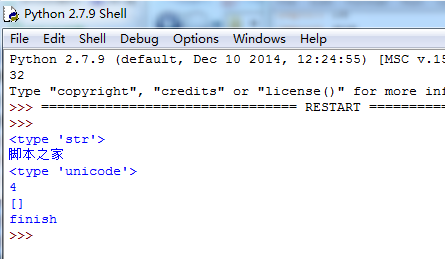Python正则表达式匹配中文用法示例
本文实例讲述了Python正则表达式匹配中文用法。分享给大家供大家参考,具体如下:
#!/usr/bin/python
#-*- coding:cp936-*-#思路,将str转换成unicode,方可用正则表达式,前提是,要知道文件的编码,本例中是gbk
import cPickle as mypickle
import re
import sys
if (__name__=='__main__'):
fid1=file('demo.txt','r');#demo.txt写入字符如:脚本之家
p=re.compile('(^\s+|\s+$)');
phanzigbk=re.compile('[\\x20-\\x7f]');
phanzi=re.compile(u'[\u4e00-\u9fa5]');#这里要加u,注意
commlines=fid1.readlines();
fid1.close();
dictfamilyname={};
dictfirstname={};
for line in commlines:
line=p.sub('',line);
print type(line);
print line;
uline=unicode(line,'gbk');
print type(uline);
candidates=phanzi.findall(uline);
print len(candidates);
if(len(candidates)==2):
print candidates[0];
familynamegbk=candidates[0].encode('gbk');#把unicode型的变量变成str型的变量
firstnamegbk=candidates[1].encode('gbk');
if(dictfamilyname.has_key(familynamegbk)):
dictfamilyname[familynamegbk]=dictfamilyname[familynamegbk]+1;
else:
dictfamilyname[familynamegbk]=1;
if(dictfirstname.has_key(firstnamegbk)):
dictfirstname[firstnamegbk]=dictfirstname[firstnamegbk]+1;
else:
dictfirstname[firstnamegbk]=1;
familynameitems=dictfamilyname.items();
print familynameitems;
firstnameitems=dictfirstname.items();
familynameitems.sort(key=lambda d:d[1],reverse=True);
firstnameitems.sort(key=lambda d :d[1],reverse=True);
fid=file('familyname.txt','w');
for m in familynameitems:
s=m[0]+'\t'+str(m[1]);
fid.write(s);
fid.write('\n');
fid.close();
fid=file('firstname.txt','w');
for m in firstnameitems:
s=m[0]+'\t'+str(m[1]);
fid.write(s);
fid.write('\n');
fid.close();
print 'finish'
运行效果图如下:

PS:这里再为大家提供2款非常方便的正则表达式工具供大家参考使用:
JavaScript正则表达式在线测试工具:
http://tools.jb51.net/regex/javascript
正则表达式在线生成工具:
http://tools.jb51.net/regex/create_reg
更多关于Python相关内容可查看本站专题:《Python正则表达式用法总结》、《Python数据结构与算法教程》、《Python Socket编程技巧总结》、《Python函数使用技巧总结》、《Python字符串操作技巧汇总》、《Python入门与进阶经典教程》及《Python文件与目录操作技巧汇总》
希望本文所述对大家Python程序设计有所帮助。